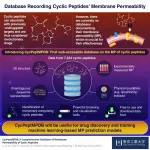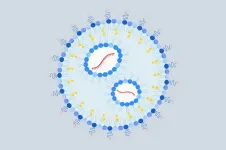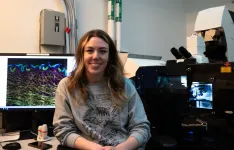(Press-News.org) In research published in Biotropica, investigators report that the Dwarf Reed Snake (Pseudorabdion longiceps) performs cartwheels when threatened. This is the first time such an active rolling motion has been documented in snakes, with images and a detailed description.
The Dwarf Reed Snake is a nocturnal, small snake that lives in regions of Southeast Asia. Typical defense mechanisms that small snakes use against predators include fleeing, camouflage, coloration, odors, death-feigning, and intimidation. Some snakes also use passive rolling, but investigators have observed that the Dwarf Reed Snake performs active cartwheeling by repeatedly launching the coils of its body into the air and rolling down inclines.
In addition to identifying a complex defense mechanism used by the Dwarf Reed Snake, the findings also provide insights into the kinetic abilities of snakes.
“My colleagues and I were excited when we successfully captured images that documented cartwheeling behavior in this species. We believe that this behavior may be more widespread in other small snake species, especially members of the subfamily Calamariinae, but the lack of records is probably an artefact of the challenges in detecting and observing these secretive species,” said corresponding author Evan Seng Huat Quah, PhD, of Universiti Malaysia Sabah.
URL upon publication: https://onlinelibrary.wiley.com/doi/10.1111/btp.13213
Additional Information
NOTE: The information contained in this release is protected by copyright. Please include journal attribution in all coverage. For more information or to obtain a PDF of any study, please contact: Sara Henning-Stout, newsroom@wiley.com.
About the Journal
Biotropica is a highly regarded source of original research on the ecology, conservation and management of all tropical ecosystems, and on the evolution, behavior, and population biology of tropical organisms. Published on behalf of the Association of Tropical Biology and Conservation, the journal's Special Issues and Special Sections quickly become indispensable references for researchers in the field.
About Wiley
Wiley is one of the world’s largest publishers and a global leader in scientific research and career-connected education. Founded in 1807, Wiley enables discovery, powers education, and shapes workforces. Through its industry-leading content, digital platforms, and knowledge networks, the company delivers on its timeless mission to unlock human potential. Visit us at Wiley.com. Follow us on Facebook, Twitter, LinkedIn and Instagram.
END
Can some snakes do cartwheels to escape or startle predators?
2023-04-05
ELSE PRESS RELEASES FROM THIS DATE:
Can phototherapy improve cognitive function in patients with dementia?
2023-04-05
In an analysis of published clinical trials, investigators found that phototherapy—or exposure to sessions of bright light—may be a promising non-pharmacological intervention for lessening symptoms of dementia.
The analysis in Brain and Behavior included 12 randomized clinical trials. Results indicated that phototherapy improved cognitive function in patients with dementia, but it did not affect symptoms of depression or sleep quality.
“Further well-designed studies are needed to explore the most effective clinical implementation ...
Could a novel small molecule slow or reverse the effects of Duchenne muscular dystrophy?
2023-04-05
In a new study published in The FASEB Journal, investigators demonstrated the potential of a molecule that may help overcome some of the devastating symptoms of Duchenne muscular dystrophy (DMD), the most common life-limiting congenital neuromuscular disorder. The agent promotes the activity of AMP-activated protein kinase (AMPK), an important fuel-sensing enzyme that is present in all mammalian cells.
Previous research has shown that stimulating AMPK can mitigate the dystrophy—or wasting—of muscles, but AMPK activators have failed to reach the clinic due to either their lack of potency or toxic off-target effects.
In ...
CycPeptMPDB: A database aimed at promoting drug design using cyclic peptides
2023-04-05
CycPeptMPDB, a novel database—created by Tokyo Tech researchers—focused on the membrane permeability of cyclic peptides, could accelerate the development of drugs based on these promising compounds. This database was created by gathering published information on thousands of cyclic peptides and organizing it neatly in an online-accessible platform. Thanks to its search and visualization capabilities, CycPeptMPDB could pave the way to new computational and machine learning methods for screening and designing drugs with cyclic peptides.
One of the ...
Brain injury toolkit helps support domestic violence survivors
2023-04-05
COLUMBUS, Ohio – A new approach to trauma-informed care developed by domestic violence survivor advocates and researchers at The Ohio State University has been found in a new study to improve support organizations’ care for survivors by better recognizing brain injury and addressing its often long-lasting repercussions.
The study appears in the Journal of Head Trauma and Rehabilitation.
CARE is the first trauma-informed approach that considers brain injury in the complex set of circumstances to be addressed and accommodated in order ...
Aging at AACR Annual Meeting 2023
2023-04-05
Impact Journals (Aging's publisher) is proud to participate at the American Association for Cancer Research (AACR) Annual Meeting 2023, which convenes April 14-19 in Orlando, Florida.
BUFFALO, NY-April 4, 2023 – Impact Journals will be participating as an exhibitor at the American Association for Cancer Research (AACR) Annual Meeting 2023 from April 14-19 at the Orange County Convention Center in Orlando, Florida. This year, the AACR meeting theme is: “Advancing the Frontiers of Cancer Science and Medicine.”
Impact ...
A cold-specialized icefish species underwent major genetic changes as it migrated to temperate waters, new study finds
2023-04-05
Many animals have evolved to tolerate extreme environments, including being able to survive crushing pressures of ocean trenches, unforgiving heat of deserts, and limited oxygen high in the mountains. These animals are often highly specialized to live in these specific environments, limiting them from moving to new locations. Yet, there are rare examples of species that once lived in harsh environments but have since colonized more temperate settings. Angel Rivera-Colón, a former graduate student now postdoc in the lab of Julian Catchen (CIS/GNDP), an associate professor in the department ...
Bacterial signaling across biofilm affected by surface structure
2023-04-05
Similar to how cells within human tissues communicate and function together as a whole, bacteria are also able to communicate with each other through chemical signals, a behavior known as quorum signaling (QS). These chemical signals spread through a biofilm that colonies of bacteria form after they reach a certain density, and are used to help the colonies scavenge food, as well as defend against threats, like antibiotics.
“QS helps them to build infrastructure around them, like a city,” ...
Researchers discover new class of ribosomal peptide with hemolytic activity
2023-04-05
Living organisms produce a myriad of natural products which can be used in modern medicine and therapeutics. Bacteria and other microbes have become the main source for natural products, including a growing family called ribosomally synthesized and post-translationally modified peptides, or RiPPs. The labs of Douglas Mitchell (MMG), John and Margaret Witt Professor of Chemistry, and Huimin Zhao (CABBI/BSD/GSE/MMG), Steven L. Miller Chair of Chemical and Biomolecular Engineering, at the University of Illinois Urbana-Champaign have been working in tandem to identify and analyze new RiPPs that could be good candidates ...
Nanoparticle with mRNA appears to prevent, treat peanut allergies in mice
2023-04-05
Peanut allergies affect 1 in 50 children, and the most severe cases lead to a potentially deadly immune reaction called anaphylactic shock.
Currently, there is only one approved treatment that reduces the severity of the allergic reaction, and it takes months to kick in. A group of UCLA immunologists is aiming to change that.
Taking inspiration from COVID-19 vaccines as well as their own research on the disease, they created a first-of-its-kind nanoparticle — so small it’s measured in billionths of a meter — that delivers mRNA to specific cells in the liver. Those cells, in turn, teach the body’s natural defenses to tolerate ...
5 Questions with CNSI’s Haley Marks
2023-04-05
Haley Marks is a project scientist for the Advanced Light Microscopy Lab (ALMS) at the CNSI at UCLA. She is a biomedical engineer with a specialty in nano-biosensor research, translational medicine, and optics education.
Since joining CNSI in 2022, Haley has served as a technical expert, providing advanced light microscopy training and services to ALMS users. Here she works on developing and optimizing ALMS’s existing super-resolution and high-speed optical methods, developing strategies and imaging tools for in vivo imaging, and optimizing and disseminating computational imaging techniques.
Haley has a passion for all things photonics, and enjoys 3D printing, materials ...




